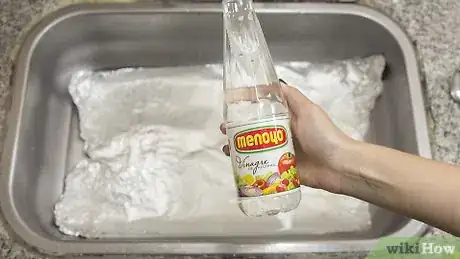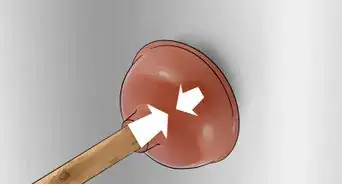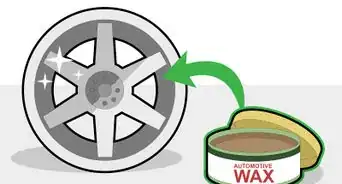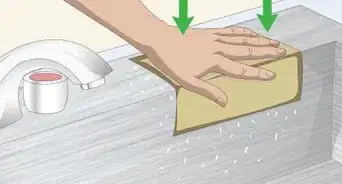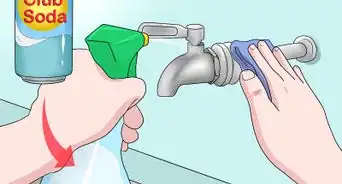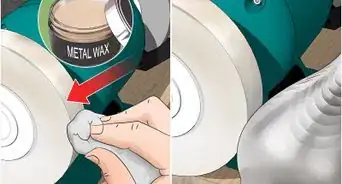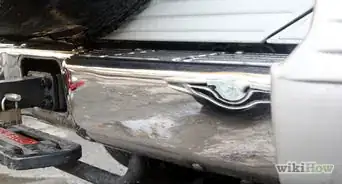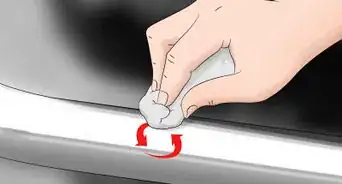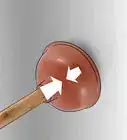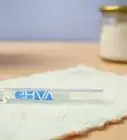This article was co-authored by Alicia Sokolowski. Alicia Sokolowski is a Green Cleaning Specialist and the President and co-CEO of AspenClean, a green cleaning company in Vancouver, British Columbia. With over 17 years of experience, Alicia specializes in creating a healthier, green alternative to chemical-based cleaning products and services. AspenClean develops and manufactures its own line of 100% Natural, EcoCert® certified, and EWG verified™ cleaning products. AspenClean’s glass cleaner was voted Parent’s Green Pick 2020 by readers of the Parents’ magazine. Alicia holds a CPA designation and a Bachelor’s degree in Commerce and Finance from the University of Toronto.
This article has been viewed 85,378 times.
Silver items look very shiny when they’re clean. However, one of the biggest problems of owning silver is that it tarnishes over time. Tarnish marks are the result of a chemical reaction that takes place naturally. Thankfully, though, there are ways to remove tarnish marks from silver. By preparing your silver properly, using baking soda to initiate another chemical reaction, and repeating the cleaning process if needed, you’ll be able to remove tarnish from silver.
Steps
Prewashing the Silver and Setting Up Your Sink
-
1Hand wash the silver. Before trying to clean your silver with baking soda, make sure that you do a light cleaning of your silver to remove any residual food or other debris. This way, you’ll make sure that your silver is cleaned as best as possible.
- Use a non-abrasive mild soap. Make sure the soap is safe to use on silver.
- Wipe down the silver with a microfiber rag or a soft dish cloth.
- Do not put your silver in the dishwasher.
- Avoid using steel wool or anything else abrasive. Silver scratches easily.[1]
-
2Plug your sink. Before you start, you need to clean and then plug your sink or basin. This is important, as you don’t want any dirt, debris, or contaminants dirtying your silver and undermining the process of cleaning.
- Use a light detergent, or even baking soda, to scrub down your sink.
- Place the drain cover securely on the drain so no water can drain out.
Advertisement -
3Cover the bottom of your sink with aluminum foil. The foil should cover large parts of the bottom of the sink or basin. The more surface and contact area the aluminum foil has, the better. Try to keep the shiny side up and don't feel compelled to make sure the foil is completely flat.
- When placing your aluminum foil, make sure to use a generous amount.
- Feel free to reuse old foil.
- The foil does not need to cover the entire bottom.[2]
-
4Place your silver on the aluminum. When placing your silver, make sure that each piece makes physical contact with a piece of aluminum.
- Place your silver in the basin gently.
- Avoid overloading the basin. You want to make sure each piece of silver is cleaned. If you need to take some out, feel free to do so.[3]
Submerging Your Silver
-
1Boil water. Boil enough water to fill your basin. This is important, as you’ll have to have enough water to completely cover any silver that you’re trying to clean.
- For a small basin or sink, you may need between 4 and 8 cups (.95 and 1.9 liters).
- Prepare more boiling water than you think you’ll need. This way, you’ll have it ready and available if you need more.[4]
-
2Add baking soda to the boiling water. After you’ve boiled your water, you’ll need to pour baking soda into it. This is important, as the baking soda is critical to the chemical reaction that will clean your silver.
- Use a quarter cup of baking soda for every 4 cups of water (.95 liters).[5]
-
3Dump the water into the sink. Once you’ve created your mixture of baking soda and hot water, dump it into the sink. Make sure to do it slowly as to not splash any hot water onto yourself or the surrounding area.
- Pour a little bit at a time.
- Stop pouring when the last piece of silver is completely submerged.[6]
-
4Watch the chemical reaction. After you’ve poured the water and baking soda in, you’ll notice a foaming effect in the sink. The foaming effect may start slowly and begin to accelerate. It should continue for up to several minutes.
- You should notice yellow flakes sticking to the aluminum foil. This is aluminum sulfide.
- It may take up to several minutes to clean lightly tarnished objects.[7]
-
5Allow the water to cool. After you’ve observed the chemical reaction, you should allow the water to sit and cool for a few minutes. This is important, as you may burn yourself if you try to remove the silver when the water is still too hot.
- Wait until the water is no longer steaming.
- Consider using tongs to remove and inspect the silver after the chemical process has completed.
- If you’re worried the water is still too hot, use a thermometer to test the temperature.[8]
-
6Inspect the silver. Take a good look at the silver and verify that the cleaning process has worked. Make sure to examine the top, bottom, and sides of the items you've cleaned. This way, you'll be able to see if they're as clean as you want them to be.
- Tarnish marks should be removed or lightened substantially.
- The silver should be extremely shiny.
Cleaning Heavily Tarnished Silver
-
1Alter your mixture. There are several ingredients you can add to your hot water to enhance its cleaning properties. If your first attempt to clean with baking soda and hot water did not work, you may benefit from adding salt and/or white vinegar to the mixture.
- Add a quarter cup (.06 liters) of salt for every four cups (.95 liter) of water -- the amount of salt and baking soda should be equal.
- If you choose to add vinegar, use a half cup (.12 liters) of white vinegar for every cup of water.[9]
-
2Repeat the process. While lightly tarnished silver may take several minutes to clean, silver that is heavily tarnished can take much longer. Thus, you may need to repeat the process several times to clean your silver. To repeat:
- Drain the sink or basin.
- Rinse the silver.
- Remove the aluminum foil and add new foil.
- Lay the silver back into the basin.
- Dump more boiling water and baking soda.[10]
-
3
-
4
-
5Discard the foil. After drying your silver, you need to throw away the aluminum foil. This is important, as the foil will now be stained and cannot be used to clean silver in the future.
- You’ll notice that the foil will be heavily tarnished. This is the result of the chemical reaction that helped transfer sulfide from the silver to the aluminum.[15]
Expert Q&A
Did you know you can get expert answers for this article?
Unlock expert answers by supporting wikiHow
-
QuestionCan you use baking soda to clean silver?
 Alicia SokolowskiAlicia Sokolowski is a Green Cleaning Specialist and the President and co-CEO of AspenClean, a green cleaning company in Vancouver, British Columbia. With over 17 years of experience, Alicia specializes in creating a healthier, green alternative to chemical-based cleaning products and services. AspenClean develops and manufactures its own line of 100% Natural, EcoCert® certified, and EWG verified™ cleaning products. AspenClean’s glass cleaner was voted Parent’s Green Pick 2020 by readers of the Parents’ magazine. Alicia holds a CPA designation and a Bachelor’s degree in Commerce and Finance from the University of Toronto.
Alicia SokolowskiAlicia Sokolowski is a Green Cleaning Specialist and the President and co-CEO of AspenClean, a green cleaning company in Vancouver, British Columbia. With over 17 years of experience, Alicia specializes in creating a healthier, green alternative to chemical-based cleaning products and services. AspenClean develops and manufactures its own line of 100% Natural, EcoCert® certified, and EWG verified™ cleaning products. AspenClean’s glass cleaner was voted Parent’s Green Pick 2020 by readers of the Parents’ magazine. Alicia holds a CPA designation and a Bachelor’s degree in Commerce and Finance from the University of Toronto.
Green Cleaning Specialist
Warnings
- Avoid this cleaning process in an aluminum sink or basin⧼thumbs_response⧽
- Do not use this method to clean silver plated items.⧼thumbs_response⧽
References
- ↑ http://www.wisebread.com/how-to-clean-silver-naturally
- ↑ http://www.17apart.com/2013/09/how-to-polish-silver-in-baking-soda.html
- ↑ http://greenopedia.com/polish-silver-without-chemicals/
- ↑ http://greenopedia.com/polish-silver-without-chemicals/
- ↑ http://www.17apart.com/2013/09/how-to-polish-silver-in-baking-soda.html
- ↑ http://cleanmyspace.com/the-besk-kept-silver-cleaning-secret-ever/
- ↑ http://greenopedia.com/polish-silver-without-chemicals/
- ↑ http://www.17apart.com/2013/09/how-to-polish-silver-in-baking-soda.html
- ↑ http://www.17apart.com/2013/09/how-to-polish-silver-in-baking-soda.html
- ↑ http://greenopedia.com/polish-silver-without-chemicals/
- ↑ Alicia Sokolowski. Green Cleaning Specialist. Expert Interview. 15 September 2020.
- ↑ http://greenopedia.com/polish-silver-without-chemicals/
- ↑ Alicia Sokolowski. Green Cleaning Specialist. Expert Interview. 15 September 2020.
- ↑ http://greenopedia.com/polish-silver-without-chemicals/
- ↑ http://greenopedia.com/polish-silver-without-chemicals/
- ↑ Alicia Sokolowski. Green Cleaning Specialist. Expert Interview. 15 September 2020.
About This Article
To clean silver with baking soda, start by washing the silver with mild dish soap and water to remove any residue. Then, plug a sink, line the bottom of it with aluminum foil, and place your silver inside of it. Next, boil enough water to fill the sink, and add 1/4 cup of baking soda for every 4 cups of water you use. Finally, dump the baking soda-water mixture into the sink, and let the silver soak in it until the water stops steaming. To learn how to clean heavily-tarnished silver with vinegar, scroll down!

